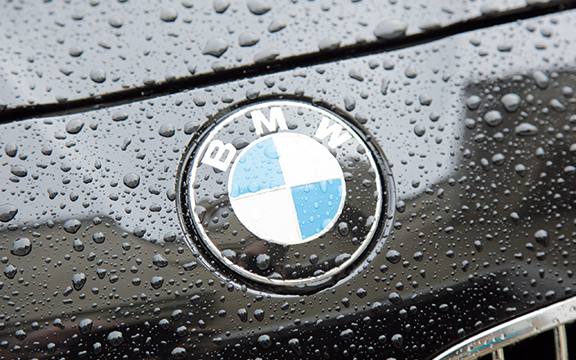Luxury Carmakers Face Headwinds In China: The BMW And Porsche Case Study

Table of Contents
The Evolving Chinese Luxury Car Market: A Landscape of Change
The Chinese luxury car market is no longer the predictable goldmine it once was. Several factors contribute to this changing landscape.
Shifting Consumer Preferences
The profile of the Chinese luxury car buyer is changing dramatically. We're seeing a rise in:
- Younger buyers: Millennials and Gen Z are increasingly driving luxury car purchases, demanding different features and experiences than previous generations.
- Tech-savvy consumers: Advanced technology, connectivity, and autonomous driving features are becoming essential considerations.
- Environmentally conscious drivers: The demand for electric vehicles (EVs) and hybrid vehicles is surging, impacting traditional combustion engine dominance.
This shift is reflected in market share data. Domestic luxury brands like Hongqi and Nio are gaining traction, capturing a larger percentage of the market, while traditional players experience slower growth. The increased adoption of EVs in China further complicates the landscape, requiring substantial investments in new technologies and infrastructure. The Chinese luxury car market is demanding adaptation and innovation to meet these evolving consumer preferences.
Economic Slowdown and Geopolitical Uncertainty
China's economic growth, a significant driver of luxury car sales, has slowed in recent years. This slowdown, coupled with global trade tensions and geopolitical uncertainty, creates a challenging environment for luxury carmakers.
- Reduced consumer spending: Economic anxieties lead to decreased discretionary spending on luxury goods, including high-end vehicles.
- Trade disputes: Tariffs and trade restrictions can significantly increase the cost of imported vehicles, impacting profitability and competitiveness.
- Government regulations: Stringent emission standards and policies promoting domestic brands add further complexities.
These factors combine to create a volatile and unpredictable market, requiring careful strategic planning and risk management from luxury carmakers. Understanding the nuances of the Chinese economy and navigating geopolitical risks are crucial for success in this market.
BMW's Challenges and Strategies in China
BMW, a long-standing player in the Chinese luxury car market, has not been immune to the challenges.
Market Share and Sales Performance
While BMW maintains a significant presence in China, its sales growth has decelerated compared to previous years. The competition from domestic brands and the rise of EVs have put pressure on its market share.
BMW's Response to Headwinds
To counter these headwinds, BMW is implementing several strategies:
- Product localization: Adapting models to better suit Chinese consumer preferences, including features and specifications.
- Targeted marketing campaigns: Focusing on reaching younger demographics through digital marketing and social media engagement.
- Investment in electric vehicle technology: Expanding its range of EVs and investing heavily in charging infrastructure to meet growing demand. The introduction of the iX and i4 are prime examples of this commitment.
These strategic moves show BMW’s commitment to adapting to the shifting demands of the Chinese luxury car market.
Porsche's Navigation of the Chinese Market
Porsche, known for its sporty and prestigious image, faces a unique set of challenges and opportunities in China.
Porsche's Unique Positioning
Porsche's brand resonates strongly with a specific segment of Chinese consumers seeking high-performance and exclusive vehicles. This positioning, while advantageous, also makes it vulnerable to shifts in consumer preferences towards more sustainable options.
Porsche's Adaption to Market Changes
Porsche is responding to market changes through:
- Electric vehicle expansion: Launching electric versions of its iconic models and investing in EV technology. The Taycan is a key example of their commitment to the electric luxury segment.
- Sophisticated digital marketing: Engaging Chinese consumers through innovative digital channels and personalized experiences.
- Prioritizing customer experience: Focusing on enhancing customer service and creating a premium brand experience that resonates with Chinese buyers.
Porsche's strategy emphasizes maintaining its brand identity while adapting to the evolving demands of the Chinese market.
Analyzing the Common Threads: Key Lessons for Luxury Automakers
Both BMW and Porsche, despite their distinct brand identities, face common challenges in the Chinese market: the changing consumer preferences, economic slowdown, and increased competition from domestic brands. These experiences highlight some crucial lessons for other luxury automakers:
- Prioritize technological innovation: Investment in electric vehicle technology and digitalization is crucial for long-term success.
- Understand the evolving consumer: Deep market research is vital to tailoring products and marketing strategies to the preferences of the Chinese consumer.
- Embrace localization and adaptation: Simply transplanting existing models and strategies won't guarantee success. Products and marketing need to resonate with the local culture.
These insights offer a blueprint for navigating the complexities of the Chinese luxury car market.
Conclusion: Overcoming Headwinds: The Future of Luxury Carmakers in China
The Chinese luxury car market presents both significant challenges and opportunities for international brands. Our analysis of BMW and Porsche reveals the importance of adapting to changing consumer preferences, navigating economic uncertainties, and investing in technological advancements. The future of luxury carmakers in China hinges on their ability to embrace innovation, understand local nuances, and deliver exceptional customer experiences. Stay informed on the latest developments impacting luxury carmakers in China – understand the headwinds and discover the winning strategies!

Featured Posts
-
 Perkiraan Cuaca Hujan Di Jawa Timur 6 Mei 2024
May 28, 2025
Perkiraan Cuaca Hujan Di Jawa Timur 6 Mei 2024
May 28, 2025 -
 Bryan County Sheriffs Office Searches For Missing Teenager
May 28, 2025
Bryan County Sheriffs Office Searches For Missing Teenager
May 28, 2025 -
 Friday Euro Millions Draw E245m Jackpot Live Updates
May 28, 2025
Friday Euro Millions Draw E245m Jackpot Live Updates
May 28, 2025 -
 Dutch Housing Crisis The Bottleneck In Converting Commercial Properties To Homes
May 28, 2025
Dutch Housing Crisis The Bottleneck In Converting Commercial Properties To Homes
May 28, 2025 -
 Hugh Jackmans Potential Involvement In Blake Livelys Legal Dispute Angers Fans
May 28, 2025
Hugh Jackmans Potential Involvement In Blake Livelys Legal Dispute Angers Fans
May 28, 2025
Latest Posts
-
 Rsalt Alshykh Fysl Alhmwd Bmnasbt Eyd Astqlal Alardn
May 29, 2025
Rsalt Alshykh Fysl Alhmwd Bmnasbt Eyd Astqlal Alardn
May 29, 2025 -
 Will There Be A Malcolm In The Middle Revival
May 29, 2025
Will There Be A Malcolm In The Middle Revival
May 29, 2025 -
 Alshykh Fysl Alhmwd Yhny Alardn Beyd Astqlalha Al Rqm
May 29, 2025
Alshykh Fysl Alhmwd Yhny Alardn Beyd Astqlalha Al Rqm
May 29, 2025 -
 A Malcolm In The Middle Revival What To Expect
May 29, 2025
A Malcolm In The Middle Revival What To Expect
May 29, 2025 -
 Altfawl Alardny Drast Latfaqyat Almyah Almbrmt Me Swrya
May 29, 2025
Altfawl Alardny Drast Latfaqyat Almyah Almbrmt Me Swrya
May 29, 2025
